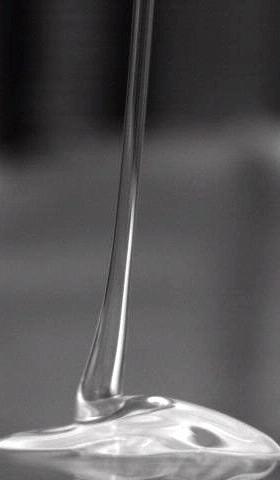Trushant Majmudar and Matthieu Varagnat have looked at the behavior of non-Newtonian, viscoelastic jets. They studied the problem of such a liquid poured out of an orifice at a given height and speed, hitting a solid surface.
Everybody has experienced such a situation, for instance, while pouring honey on to a bread slice, or pouring shower gel on to one's hand. Honey is a purely viscous, Newtonian fluid; the jet thins continuously and coils regularly. This behavior of Newtonian fluids (Figure A) has been well studied [1], but we added another level of complexity by studying viscoelastic jets.
 Figure A |
 Figure B |
 Figure C |
A. Coiling of silicone oil, a Newtonian liquid. B. Folding of a CPyCl jet. C. Leaping shampoo. Scroll down to the videos section for movies. |
The main non-Newtonian fluids we used in the study were cetylpyridinium chloride (CPyCl) wormlike micellar solutions. Jets of this fluid show novel behaviors: the jet widens at its base (reverse swell phenomenon) and folds back and forth on itself (Figure B). Both are a result of the interplay of non-Newtonian properties (viscoelasticity, shear-thinning etc.) with the gravitational, viscous, and inertial forces in the jets.
We have mapped the jetting behaviors in the parameter space composed of the height of fall, the flow rate, the viscosity and the elasticity of the fluid - or the dimensionless numbers formed by combining these variables. In addition, we have provided rationale for transitions between regimes, as well as predictions for the dependency of folding amplitude, folding frequency and the amount of reverse swell on various parameters.
Jets of some shampoos show another behavior, the leaping shampoo or Kaye effect (Figure C). The jet bends and slides on the top of a mound of liquid, jumping as high as 5 cm for a jet radius of 1 mm!
Videos
 Video A |
 Video B |
 Video C |
A. Coiling of silicone oil. B. Folding of a CPyCl jet. C. Leaping shampoo (high speed recording). |
References
- N.M. Ribe, Coiling of viscous jets, Proc. Math. Phys. Eng. Sc., 460, 2051, 3223-3239 (2004)
